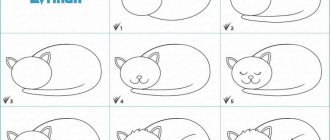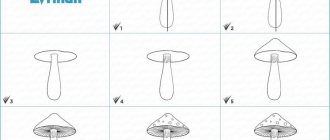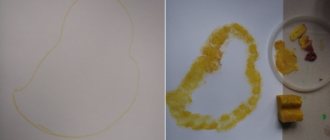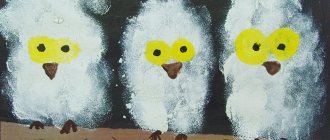Game 1. Grammar game “What is cooked from mushrooms”
The game will teach the child word formation - the ability to form a new word by analogy (following a model), for example:
- soup, sauce, salad - mushroom,
- noodles, filling, caviar, mushroom casserole,
- cutlets - mushroom,
- all dishes that the chef prepares from mushrooms are mushroom dishes (mushroom salads, mushroom sauces, mushroom casseroles).
and also develops the child’s linguistic sense.
Part 1. Invite the children to imagine that they are now not children, but... cooks! You can put a real white cap on the child's head. If you don’t have a cap, you can use a paper chef’s badge on a string (hang the badge around your neck like a medal). You can download the Little Chef Medal
Or you can use “magic”: say “magic words” in unison (“Turn around once or twice. Quickly turn into a cook!”) and even wave your magic wand.
Now we are chefs! The cook knows how to cook different dishes. And every dish he makes is very tasty, beautiful, aromatic. Today, chefs prepare dishes from mushrooms.
What can be made from mushrooms?
Now we will make mushroom soup. It is called…. How? ( mushroom soup ). What do we put in it? (list products). Remember with your children how mushroom soup is cooked.
Ask - is the soup fried or boiled? If it is boiled, then what is it cooked in - in a frying pan or in a saucepan? Is it possible to cook soup in a frying pan? Why? While playing, we depict all the actions: take an imaginary “pan,” cut mushrooms, put them in the pan, etc. We inhale the aroma of the resulting soup and figure out who we will treat it to. You can immediately “pretend” treat the toys and each other and praise the soup (you will find words and descriptions of the dishes a little lower in this article).
You can also make... caviar from mushrooms! What will it be called? Mushroom caviar - what kind of game is this? If the child finds it difficult to answer this question, then tell him: “Caviar from zucchini - zucchini caviar. Eggplant caviar - eggplant caviar. And mushroom caviar is what caviar is. ..?” (questioning intonation and pause for the child to answer). Correct answer: mushroom caviar.
We depict with actions (pantomime) how we all make mushroom caviar together: we cut mushrooms and vegetables. fry them, put them in jars, close them with lids, put them in the refrigerator for storage (This is important: all actions are depicted “for fun”, pantomime is a game! In this game, there is no need to require the child to screw real lids on the jar, sign the jar, count , how many pieces of vegetable he put in it - the baby should be focused exclusively on speech and speech tasks. Everything else is done as in a regular game - in a folded form - “as if” we took the jar, “as if” we put it on a shelf)
Today we, the cooks, have another order - to make a casserole with mushrooms for the kindergarten. What should we call it? Potato casserole is potato casserole, cabbage casserole is cabbage casserole, and mushroom casserole is what kind of casserole? What is it called? ( mushroom casserole ).
The last order is to make a salad with mushrooms for the squirrel’s birthday. Salad with mushrooms is called... what do you call it? ( mushroom salad ). Let's come up with an interesting name for our mushroom salad: “Squirrel Joy”, “Mushroom Basket” (come up with a name with your child and the name, and what you put in the salad for the squirrel and depict how you and your child prepare it).
Now let's bake some pies. And we will also have mushroom filling. What is this filling called? Mushroom. These are pies with mushroom filling.
You can also make noodles from mushrooms! It’s called “ mushroom noodles ” or cook mushroom sauce - what is it called? ( mushroom sauce) You probably already guessed what the mushroom cutlets are called? Mushroom cutlets !
And the gravy with mushrooms is called... what? ( mushroom sauce)
Mushroom stew - what do you call this stew? ( mushroom stew )
After the children and I have “made” all the dishes, we share our impressions. You can “praise” your favorite dish: “I have mushroom cutlets - delicious, crispy, crispy.” “And I have ready-made pies with mushroom filling, decorated with dough braids,” and so on. You can “brag” one by one, or you can all come up with a way to “praise” your dish, choosing as many words as possible - descriptions. Help the children find meaningful words to describe these dishes.
An approximate dictionary for describing dishes and developing the expressiveness of children's speech in this game:
hot, warm, soft, fresh, fried, baked, flaky, tasty, rosy, aromatic, fragrant, tasty, crispy, grainy, juicy, sweet, salty.
Useful idea for child development:
Show your child at home how you cook mushroom soup and name all your actions as you go.
Verb dictionary for this comment:
- I wash it, clean it, cook it, put it in, cut it, cut it into pieces, grate it, put it on the fire, remove it, stir it.
- actions with mushrooms: mushrooms are dried, pickled, stewed, cut, salted, fried, and made into soup.
Such commentary will be very useful for the development of the child’s speech. Research shows that children who frequently hear the correct forms of words do not make mistakes in their use in speech. The words “rub” (tru - trem -tret), “clean” (clean - clean - clean), “cut” (cut, cut, cut) are not as simple for children as they seem to us. By explaining what you are doing, you simultaneously develop the child’s speech and prevent typical speech errors such as “rubbing” instead of “rub”, “cleaning” instead of “cleaning”, “mixing” / “kneading” instead of “interfering”, “laying down” instead of “ I’m putting it.” Involve your child in your actions and ask: “Do you want to wash with me? What are you doing right now? What am I doing? Yes, you wash, I wash. You and I wash the vegetables together. What vegetable are you washing? Which vegetable have you already washed? Which one will you wash now? What a wonderful helper you are! Thank you for your help!".
Part 2. At the end of the game, ask the children a grammatical riddle: “Guess what I asked:
The riddle is aimed at developing linguistic flair and the ability to agree in gender between adjectives and nouns.
Mystery:
- fresh, tasty, aromatic - is it caviar or salad? (If the child answers “Mushroom salad,” then ask him again: “Do we really say that: delicious mushroom salad? No! As we say about salad: delicious mushroom salad. So, what is it?”)
— fresh, fragrant, delicious — is it a soup or a casserole? Right! What would we say about the casserole? A fragrant delicious casserole,
- Mushrooms are delicious and aromatic - are these cutlets or pie?
Helpful Tips:
— Don’t forget to turn the children from chefs back into ordinary preschoolers at the end of the game :). This can also be done with the simplest “magic words”: “One, two, turn around!” Turn into Misha (child’s name) again!” or “One, two, spin! Find yourself home again!”
— When playing with children, do not forget that cooks behave in accordance with their profession and do not behave like children. They can't throw a pan on the floor or chop mushrooms carelessly. Therefore, try to convey the peculiarities of the cook’s movement yourself, and the children will imitate you. The main thing is to treat your child in this game like a real chef - very respectfully, ask him for advice, be interested in his opinion, you can even call him by his first name and patronymic: “Dear Mikhail Grigorievich, can we already start making mushroom caviar? Okay, let's begin then. What do we need? Don't step out of your role!
- If the child begins to behave differently from the cook, remind him that he is not a boy/girl now, but the cook and his dish are very, very waiting (name who is waiting and why his dish is needed). Therefore, you need to try and “cook” it tasty so that people are happy and eat it with pleasure. This is often enough for the child to remember his role in the game.
- Second version of the game: the second time you play this game, change it and play it in the second version.
In the second version of this game, children will learn to use nouns in the genitive case: from chanterelles (and not “from chanterelles” - this is a mistake), from boletus, from volnushek, from boletus, and so on.
For this option you will need “Mushrooms” cards. You can download them for free in the article “Mushrooms. Pictures for children".
Place the cards face down on the table (You will need edible mushroom cards with several mushrooms on them). The roles of cooks are played by children players in turns.
Step 1. The cook takes a card and names the mushrooms shown on it. Decides what he will make from them: “I will cook mushroom soup.”
Step 2. Everyone guesses what he will use to make mushroom soup (or any other dish he has chosen): “Are you going to make mushroom soup from chanterelles? from champignons? from boletuses? from boletus?” until they guess. Everyone guesses one by one.
When the player has guessed, the presenter shows his card and confirms the correctness of the answer, for example: “Yes, I will cook chanterelle mushroom soup.”
You can introduce the following rule of the game: add “penalty” pictures—poisonous mushrooms—to your set of cards. If a child recognizes an inedible mushroom and immediately says: “I have a poisonous mushroom. This is...(name of mushroom)", then he can take a new card. And continue to participate in the game. If he does not recognize the poisonous mushroom and “cooks” a soup or other dish from the poisonous mushroom in the game, then he misses his turn in the next round. Or he pays forfeit.
how to introduce your child to edible and poisonous mushrooms from the article “Mushrooms in fairy tales, stories, pictures, tasks and educational videos for kids.”
The game can be played in pairs, in a small subgroup of children, or with a large group of children. If you play with a large group of children, then the children play as one team. For example, one child - the leader - chooses a card. And the whole group of children guesses what is depicted on it. If the leader, the cook, makes a mistake, then a group of children corrects him, for example: “No, you need to cut it first and then put it in the soup.” Then a new leader is selected by counting.









